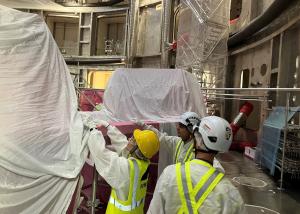Space solutions for terrestrial dust
Satellite cleanliness engineering will help protect the ITER tokamak from construction contamination.
When the ITER vacuum team realized that the level of construction debris and concrete dust in the Tokamak Building meant key components were getting so dirty that the machine might never operate to specification, they turned to a surprising place for help: space.
"A high level of cleanliness is required for the operation of a vacuum machine and this wasn't the case with our components," explains Liam Worth, the Vacuum Systems Project Leader at ITER. "We needed a solution and we saw parallels with aerospace because satellites need to be kept clean during manufacture, stay clean while awaiting launch, and remain operational once they are in space where they can no longer be accessed."
In an ideal world, a fusion reactor would be assembled in a clean room to ensure nothing could contaminate the components and undermine or even disable the tokamak altogether. However, due to schedule constraints, the reality at ITER is much different and tokamak assembly is taking place while there is still construction ongoing. Future commercial fusion reactors will also likely be assembled in buildings prior to the completion of civil works, which means the cleanliness protocols established at ITER can serve as guidelines for the broader fusion industry.
While the vacuum team at ITER was aware that the construction activities were creating pollution in the Tokamak Building, the extent of the problem only became clear when a mandatory cleanliness report was required after vacuum vessel sector #6 was brought into the pit in 2022. The report showed concrete dust contamination on pit surfaces, an abundance of metallic particles from milling known as "swarf."
"We had traditional cleaning methods such as chemical wiping, but as assembly progresses, the complexity of the system means there will be areas we can't physically get to," says Liam. "We needed a technical and philosophical change to get people to understand that it was essential to establish the cleanliness from the start because it will be impossible to clean later."
For help developing the new cleanliness protocols, the vacuum team turned to OHB, a German systems integration company specializing in the aerospace industry, particularly in the assembly and operation of satellites for a range of customers including the European Space Agency. Because OHB requires rigorous cleanliness engineering for its space operations, the company created an internal Cleanliness Competence Centre (C3). Starting with the target performance, the cleanliness experts break down acceptable contamination levels and then develop mitigation, avoidance, standard and emergency cleaning, and "stay clean" concepts. This cleanliness engineering approach is also provided to external clients such as semi-conductor facilities or hospitals seeking to reduce contamination that could lead to infection risk during surgery.
As it happened, the senior expert for contamination control at OHB, Axel Müller, was a fusion enthusiast who studied plasma physics at the Technical University of Munich and even worked at the ASDEX Upgrade tokamak in Garching. Müller immediately saw how the engineering of space cleaning could be applied to ITER.
"They are both one-off production projects, which means they are unique designs and you can't just apply existing standards," says Müller. "For satellites, we develop all the methods and tools we need to do the specific cleanliness job. We are developing a slightly larger system with ITER but it's the same concept: control the small parts and then scale up the standard."
Müller saw two other important similarities between space and fusion. First, they both required international cooperation and a shared supply system where contracts were divided among the members of the project. When OHB was involved with cleanliness engineering for the European Space Agency, the supply chain was spread out across the European Union, just as the ITER supply chain is spread out around the world. This means cleaning protocols must be adjusted so the gaps in cleanliness resulting from different suppliers can be addressed when the components arrive on site.
The second big commonality was the time scale involved in the two projects. Because tokamak assembly requires years, many components need to be kept clean for long periods before they can be installed and preserved, in situ, prior to machine operations.
"Space is similar to ITER," says Müller. "You might build a satellite and then it sits for a while before launch, so you have to keep it clean on the ground."
Towards the end of 2022, OHB and ITER started two cleanliness recovery projects together, both named after Crius, the Greek god of the constellations, to evoke the idea of different parts working together. With the CRIUS I project, OHB evaluated an approach to the in-situ cleaning and cleanliness verification operations of vessel sector modules installed in the pit. Then, CRIUS II established possible cleaning concepts and development plans for the implementation of prototypes for specific cleaning tools and protective textile covers for ITER components.
Under the plans currently being devised for the CRIUS III phase of the cleanliness engineering project, a series of critical milestones in the cleanliness chain are being identified such as transport, acceptance of goods, or installation. A cleanliness compliance contract will be established for each milestone and both contractors and ITER personnel will have to sign off on cleanliness before moving ahead. For storage on site, OHB plans to adopt bespoke textile covers that are based on the protection used for satellites.
"We now have a reasonably well-developed concept for cleaning methodology," says Liam. "The next step is to develop this into a fully operational system and then go in and actually do the cleaning."



